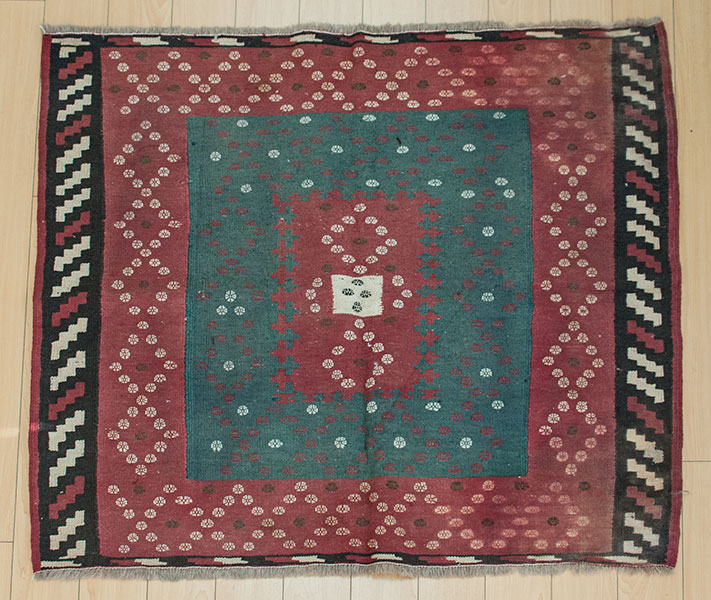|
|
Afshar of Kerman
Their Sofrehs, like their Namakdans, have much variety owing to the special position of Kerman and its various tribes.
Notwithstanding the variety in design, color and manner of weaving, sofrehs of Afshar have rectangular feature and are Ardi type.
No long dining sofreh has been obtained from Afshar.
In their sofreh, coloring is very interesting. Bright happy colors of their sofrehs may not be found in any other region.
Structure of sofreh of Afshar is very divergent, having a combination of various weaving, like uniform kilim, double interlock and weft wrapping.
Two sides of these sofrehs, according their own style, is vertically weft wrapped by two antonym colors, like two pillars (interlocked-chain). In above and below, a few wales of kilim weaving in two antonym colors or some wales of normal weaving or tablet weft of two antonym colors could be seen.
Afshar of Khorasan
There is only a few sofrehs woven by this tribe, having no relation with sofreh of Kerman.
Those, somehow, resemble the woven works of Afshar of Kerman.
Baluch
Baluch of Khorasan have an important share in sofreh weaving. They have woven many Ardi sofrehs, as well as dining sofreh. The former type, like other tribes weaving, is square with 1x1 sq. m. dimension, but their dining sofreh are woven in much divergent sizes, some very small and some are medium size. No long sofreh is found in their works.
Most of Baluch sofreh are flat weave. In some of these sofrehs, other weaving methods, such as weft wrapped is used.
Some parts, like margin and some of middle motives, are pile woven and the latter group is much interesting. Ground of Baluch sofreh is soil-colored, woven of camel wool with fine and ornamented margin.
Effect of adjacent Baluch of Khorasan, like Kurd and Afshar in sofreh weaving of this tribe is obvious.
Lor of Bakhtiari
There are many sofrehs remained from Lor of Bakhtiari. Those are Ardi, having square dimension, with the same similarity to their salt containers.
All of those sofrehs have a simple combination. Ground of sofreh is divided into two or more sections and in each section uniform and repetitive lozenge images are woven.
Ground is of cotton yarn and its weaving type is kilim weaving double interlocks.
No dining sofreh was seen in this group, one may guess that some of their woven called "Shushtari", or their plain floored kilims might be used as sofreh.
North-west Kurd
A few Kurdish sofreh, woven in the West of Iran, simply is compensated by North-west woven Kurd of Northern Khorasan, still weave sofreh so far, and use their woven in everyday life of themselves. These sofreh are usually rectangular, mostly small or medium, some long and narrow.
Square sofreh is not woven in this region.
Its design and combination turns around only a few patterns. Ground or at least, the image and color is soil-like and is woven of camel wool. Around this plain ground, designed or plain margin is added.
Sometimes, there is some pile weaving over the middle image and margin in Kurdish sofreh (This method is also applied in Baluch ones.). Image of Khorasan Kurdish sofreh is also different.
A combination of uniform kilim and weft weaving or weft wrapped or relief flower with supplementary weft is used in This kind of Kurdish sofreh.
Qashqai and Khamseh
There is no woven work from these two great tribes, except limited woven sofrehs.
Shahseven Tribes
Not many sofreh is remained from Shahseven.
A few items offered to market is scarcely comparing to their other hand woven.
Perhaps some of their verniers, specially square and rectangular, with imageless and plain ground, have been used as sofreh.
Varamin
The exceptional location of Varamin Plain and its divergent groups, residing since long in this plain, caused some of the most interesting hand-woven in this region, like sofreh and namakdan of Varamin.
Coexistence of various people of Kurd, Lor, Shahseven, Khamseh, Qashqai, Afshar and their reciprocal effect on each other, caused extreme creation over Varamin hand-woven, such as sofreh and namakdan.
Although mixage and amalgamation of Varamin woven, made those distinguishing difficult, but not impossible.
Ground of Varamin Sofrehs are mostly of un-dyed camel wool, natural color.

|
|

